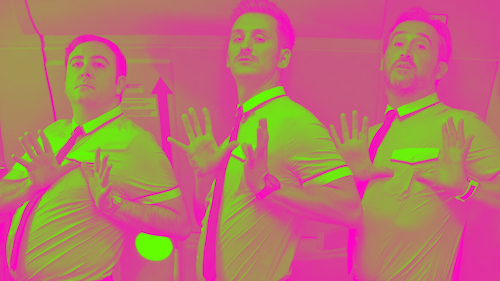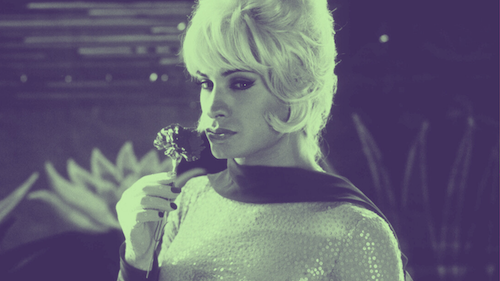Filmography Worship: Ranking Every Pedro Almodóvar Film
Written by Andreas Babiolakis
Filmography Worship is a series where we review every single feature of filmmakers that have made our Wall of Directors
There aren’t many careers that mirror that of Spanish icon Pedro Almodóvar Caballero (or just Pedro Almodóvar for short). He represented pure rebellion at the start of his career, and it’s easy to see how. He always wanted to study film and went to school for it at the National School of Cinema in Madrid; this institution was closed by dictator Francisco Franco, whose reign lasted from 1936 to 1975. Almodóvar sought to teach himself how to make motion pictures as a result. An aficionado of the punk scene and counterculture cinema’s underground movements, Almodóvar was working his way towards a very angry angle: one that opposed the ruling of Franco’s Spain and aimed to destroy the semblances of forced “order”, including how motion pictures could be told (although Almodóvar wasn’t actively trying to deconstruct film; his medium just so happened to get in the way of where his anger was directed). These works resembled the anarchistic statements made by like-minded cinematic rebels, like John Waters (who Almodóvar feels inspired by) or Harmony Korine (who came after).
It took some time for Almodóvar to get his feet wet, with a handful of jarring, unhinged, uninhibited films that already had much to say and some methods that felt impossible to ignore. He was already exercising sexual liberation (particularly that of LGBTQ+ culture), vicious violence, and all things unapologetic and loud (even the colours were vibrant). Around What Have I Done to Deserve This? in 1984, Almodóvar was starting to try to hone his visions and ideas into something more cohesive and structured narratively, although he would continue to push boundaries whenever he saw fit. Shortly afterward, he and his brother, Agustin Almodóvar, founded the production company El Deseo in 1986. It was clear that this cinematic medium didn’t just have to be a vessel to share disdain and frustration. Almodóvar could share whatever story or images he desired, and it didn’t take him very long to figure this out (maybe a half dozen films).
Towards the end of the decade came Almodóvar’s breakthrough film, Women on the Verge of a Nervous Breakdown: his answer to the screwball comedies of yesteryear with his own style and prioritizations throughout. Even well before this comedy juggernaut was released, Almodóvar was always telling stories of women, all walks of queer life, and the varying middle, working, and lower classes of Spain. He gave life and credence to the voiceless who are almost always shunned in film. Again, Almodóvar plays by his own rules, and that was always evident. With Women on the Verge of a Nervous Breakdown, he took his progressive ideas and his adorations of older film genres once again and made a comedy for the ages. He made a few notable films before this moment, but this is precisely where Almodóvar was set to be one of the greatest directors of our time: a singular voice who knew what he wanted (and now how to make it happen).
Almodóvar had the keys to drive, and at first, he pressed the pedal to the floor and sped as quickly as possible with daring, taboo, controversial films, like Tie Me Up! Tie Me Down! (which was glaringly given an X rating at the time) and High Heels. Once he reached works like The Flower of My Secret and All About My Mother, he had found his way again, and this time for good. His films were once quite easy to label via their genres, tones, and motivations. Now? He had become an expert in idiosyncrasy with films that didn’t fit any one description. It was by this point that the prime of Almodóvar’s career truly began, and he’d release hit after hit after hit. Almodóvar is still going with this hot streak and is one of the very few directors to have a masterpiece in every decade he has worked in (from the eighties until the twenties). It’s difficult to narrow down what Almodóvar’s films are like individually, but we are more than acquainted with his style overall.
What are some major traits of Almodóvar’s films? Vibrant colours, especially the usage of primary hues (particularly that deep, Spanish red), genre-bending peculiarities alongside history-traversing cinematic references and homages, and the locating of light amidst darkness and hardship amidst joy. Almodóvar’s films are able to make us feel and experience things and ideas many other directors could only dream of. Almodóvar’s films have us skip between reality, dreamlike realms, and through the fourth wall. They exist in their own dimension, and Almodóvar allows the portal into his mind and heart to be an easy one to climb through. As challenging as his bold choices can be, Almodóvar’s films never feel pretentious or alienating. Quite the opposite, in fact. Almodóvar knows how to make the difficult feel obtainable and understandable. He is also known for his usual veterans that pop up in a number of his films, some of whom have been successful out of Spain afterward (Antonio Banderas, Penélope Cruz) and others who are titans of their nation (Celia Roth, Rossy de Palma, et cetera).
Almodóvar’s a champion of female voices and maternal heroines, all members of the LGBTQ+ community, all genres of film under the sun and the new ways we can explore them, and so much more. He started off via his own intuition and passion and never lost sight of his capabilities. To this day, decades into his career, he continues to push himself to trek new terrain, and I’ll venture wherever he travels. With only one bad film out of many releases (more on that shortly), it’s safe to say that Almodóvar has a really strong filmography with more than enough brilliance to explore time and time again. I won’t be covering Almodóvar’s short films because I feel like there are enough feature films to make this a long enough list, and one I have wanted to cover for a very long time. I cannot wait to go through the filmography of one of my favourite directors of all time, and easily one of the strongest living auteurs. Here are the feature films of Pedro Almodóvar ranked from worst to best.
23. I’m So Excited!
The only film by Almodóvar I flat-out don’t ever need to see again. I’m So Excited! is a sillier comedy film made after a string of depressing, harrowing works, and it’s clear that Almodóvar needed to find some spirit and joy in his life again. That I respect. What I don’t care for is a film this vapid: one where logic is tossed out the window, characters overstay their welcome, and we are trapped in the confinements of an aeroplane and two airports for an entire runtime. You see, a fun film has to actually be fun. Perhaps it was a ride on set for Almodóvar and company, but it just doesn’t translate to the big screen for the rest of us. At least he tried to do something a bit unique and fresh — in his signature way — with I’m So Excited!, but that only helps the film look nice and have a bit of imagination amidst the seas of mediocrity. This one is for Almodóvar completionists only (he’s also made way better comedies, so those looking for lighter Almodóvar films don’t need to start here either).
22. Pepi, Luci, Bom
As weird as it sounds being this far down on a list, I’ll state that every film from this point on is worth seeing for those who are curious (but maybe section off these early Almodóvar films for the more daring of you, dear readers). His debut feature film, Pepi, Luci, Bom, is as chaotic as his films get: a black comedy with three spiralling storylines shot on 16mm and blown up to 35mm. This is straight from the underground and an abrasive watch (as are most early Almodóvar works), but I think — as long as John Waters’ early works have been reappraised over time — this film is worth revisiting with the eyes of a new generation looking back. This is a messy film, but an effective one nonetheless.
21. Labyrinth of Passion
Labyrinth of Passion is as punk as Almodóvar gets. A highly provocative and edgy work, Labyrinth of Passion sees Almodóvar making political statements and drawing controversial lines whilst also fighting for progressive commentary on LGBT notions (including the then-prevalent AIDS crisis, as well as transgender identities). It’s another sloppy Almodóvar effort that has enough interesting ideas within it to feel watchable for his biggest fans (or those who are looking for a challenge).
20. Kika
Almodóvar considered two of his own films to be his weakest: one included the beloved cult classic Matador. Then there’s Kika, which more people agree with Almodóvar on perhaps due to its desire to go too far in terms of darkness (with a comedic angle), visual style, and hyperbolic tone. I feel like Kika has a pulse, which keeps me from feeling as critical about it. It’s not a great film by any means, but Kika is still interesting and different enough to feel worthwhile, to me anyway. Will you be in the same boat as me, or will you despise Kika? That’s up to you to find out, but I wouldn’t blame you for feeling as sour about the film as most others do. Maybe the nostalgia and peculiarity of Kika got to me.
19. Dark Habits
Dark Habits feels like Almodóvar’s answer to Michael Powell and Emeric Pressburger’s Black Narcissus regarding the eroticism found within a convent of nuns. Dark Habits was made for a different era, mind you, and what was considered taboo in Black Narcissus would seem tame by the standards of the eighties. So, naturally, Almodóvar goes further with a rock n’ roll angle, drugs, sexuality, and all. Another early and combative film by the auteur, Dark Habits attacks Christianity due to the controlling nature of the religion when in the wrong hands, especially towards the queer community (and society as a whole, when regarding Francoist Spain). While it won’t be everyone’s favourite, I find the artistry and cohesion of Dark Habits to be an elevation on what Almodóvar was trying to tackle with his preliminary motion pictures.
18. High Heels
We’re going to start reaching some more recognizable titles, including the highly popular High Heels, which I’ll go on record to state is definitely a weaker Almodóvar film that sits comfortably on this list with the earlier films when the director was still trying to find his balance. It’s like Almodóvar was enjoying being this controversial figure with this rift between a mother and daughter within the entertainment industry. I still think that High Heels is a good-enough film particularly because of the claws Almodóvar is willing to unleash when discussing the state of television, music, and film with his own brand of taboo, but I also don’t think this film is anywhere near the height of his capabilities despite its notoriety.
17. Matador
I feel like there’s a bit of a leap from this point on in Almodóvar’s filmography on this list. Even so, I think Matador — an important early film for Almodóvar for sure — is a strong enough work that doesn’t quite compare with his greatest releases. Nonetheless, Almodóvar truly dives into the minds of his characters in this twisty thriller full of sexuality and shocks. It doesn’t feel like he is making choices just to repulse audiences by Matador: Almodóvar feels far more in control with his ideas and executions here (even though he’d continue to get even stronger). I’m not quite sure why Almodóvar feels so strongly against this release given the importance and legacy Matador has sustained. If you want to see one of the more extreme works by this director, look no further than Matador, or…
16. Tie Me Up! Tie Me Down!
I feel like the milieux surrounding Tie Me Up! Tie Me Down! is larger than the film itself, including its infamous X rating (which encouraged the MPAA to create the NC-17 rating, as Tie Me Up! Tie Me Down! was considered extreme but not pornographic, so the appropriate rating was apparently necessary). There’s the concept about gaslighting and manipulation (in and out of the bedroom), Ennio Morricone’s score (which Almodóvar only used parts of), and the tall order of following Almodóvar’s breakthrough, Women on the Verge of a Nervous Breakdown. There’s much in terms of the mythos of Tie Me Up! Tie Me Down!, but the film itself is only slightly better than Matador (maybe it’s the strengthening assuredness here) and is equally as controversial. I believe both films were deemed overly provocative for their time and are now being championed as overlooked masterpieces. I’d go somewhere in the middle: both films push buttons and boundaries enough to work, but Almodóvar has also done better.
15. The Room Next Door
The first English language film to make this list is Almodóvar’s debut feature film of the matter, The Room Next Door. While a bit gets lost in translation (the dialogue, especially during the more expository opening act, is far more stunted than the colourful and existential prose we are used to getting from the auteur), there are still many instances of Almodóvar’s filmmaking glory. As the film progresses and our two leads (played by Tilda Swinton and Julianne Moore to great effect, in a way that evokes the melodramas of Hollywood yesteryear) travel to the distant destination to anticipate the pending fatality of one of these characters, Almodóvar takes the otherwise realistic film into a place that is in between life and death (an architectural limbo, if you will). The Room Next Door descends into an artistic take on the ghost story, as if the departed are still here on Earth with us and that the afterlife is, as stated in the title, right by us at all times. The Room Next Door is sadly a teensy bit flawed because of some language and cultural conversion issues, but otherwise it is a triumphant, enriching effort by a director in his old age who is not only thinking about how much time he has left: he is enjoying every minute as they come.
14. Law of Desire
Before Women on the Verge of a Nervous Breakdown, the best films Almodóvar made in the eighties possessed the most amount of personal connection and care for its characters. Such is the case with Law of Desire, which sees a love triangle between a director, his male muse, and the latter’s transgender sister. While comedic and satirical in tone, law of Desire is willing to get serious in a melodramatic way, which results in legitimate thrills and the kind of shocks that don’t come from trying too hard: these jaw-dropping moments are earned. This film was the start of Almodóvar’s international recognition, preparing the hot seat for Women on the Verge of a Nervous Breakdown one year later, but that doesn’t mean Law of Desire should be overlooked. I’d call every film on this list from this point on great, and Law of Desire is equal parts powerful and coruscating.
13. Live Flesh
Despite how willingly Almodóvar was to dive head first into being a provocative filmmaker (sexually and through violence), Live Flesh is a moment where the Spanish great was dialling it back to see what he could accomplish with insinuation over blatancy. While still an experiment (Almodóvar would yield stronger results shortly afterward), Live Flesh is a great tango between showing and telling that doesn’t get enough love. Featuring some early artistry that latter period Almodóvar fans would be quite familiar with (a maturity that eighties Almodóvar didn’t always showcase), Live Flesh is a necessary bridge (like The Flower of My Secret two years prior) between the rebellious and prestigious sides of Almodóvar’s career.
12. The Skin I Live In
The first Almodóvar film I ever saw, I wrote off The Skin I Live In as being a rip-off of Georges Franju’s Eyes Without a Face (which I would gladly place in my top ten favourite horror films of all time). I was in film school and thought I knew everything. What I missed until I revisited this psychological thriller is how Almodóvar was merely tributing Franju’s classic while putting a spin on how horror could be perceived after years of slasher blockbuster nonsense. As a more seasoned cinephile now, I was dead wrong about the mysterious, enigmatic richness of The Skin I Live In: a rare melodrama that doesn’t put all of its cards on the table in an upfront fashion. I’d love to see Almodóvar return to the horror genre with this much directness, but if this is the last such film we get, The Skin I Live In is a great effort by a director who doesn’t typically dabble in the genre.
11. Julieta
Almodóvar has always explored his female characters, be they mothers or not. Julieta is one of his most complete studies of such roles, as the titular character is portrayed by two stars (Emma Suárez and Adriana Ugarte portray Julieta at different ages). We watch the tribulations and grieving periods of Julieta in dynamic, tragic fashion; this is to know the weight of generational trauma and heartbreak. Despite some comparable attempts by other directors, not once does Almodóvar feel like he is exploiting his female protagonist like many have time and time again. There is a sense of care and empathy here: the kind that has rippled in Almodóvar’s career no matter how dark or relentless his films can get. Julieta is as bare bones as an Almodóvar drama gets, and even then it is risky and creative enough to tell a fuller story of depression.
10. The Flower of My Secret
Almodóvar is far from the first director to question what it means to be an artist or storyteller, but his ways of doing so are so fascinating. Case in point, here is The Flower of My Secret: a film about a harlequin romance author whose turbulent life finds her novels getting more twisted with each release. Art can be a catharsis, and this film recognizes that as well as it works towards a conclusion of healing, not of the deep end. It’s a transitionary film for Almodóvar that proved that he learned how to pull back when needed, and that films require a yin and yang in order for the darkness to truly work. Perhaps one of the more underrated Almodóvar films (alongside the next entry on this list), The Flower of My Secret is a stellar depiction of what art means not just to the audience but to the artist as well.
9. What Have I Done to Deserve This?
The earliest film in Almodóvar’s filmography that I would consider terrific is this oft-underseen gem, What Have I Done to Deserve This?. Equal parts an answer to Italian Neorealism and the melodramatic hyperboles of Rainer Werner Fassbinder, this black comedy knows how to go extremely far (but also know how to tell enough story and build its characters sufficiently, particularly protagonist housewife Gloria, so that every moment is effectively hilarious or horrifying). A tapestry of taboo themes and ideas, What Have I Done to Deserve This? is over-the-top done right: a distressing collapse in agony caused by a string of bad luck (most dished out by a life that doesn’t care about that, Gloria, who is living it). It is at this point that this film is comparable to one last release: John Waters’ Polyester (these two films would make for a great, darkly comedic and bleak double billing).
8. Broken Embraces
While Almodóvar has toyed with the traits of the films of Alfred Hitchcock time and time again, Broken Embraces may be his most Hitchcockian effort (and what a terrific homage this is). Full of layers, twists, perspectives, and turns, Broken Embraces is a film that keeps you guessing and glued to the screen due to its pulpy electricity (if not for the eye-candy cinematography by Rodrigo Prieto). While yet another commentary on the filmmaking process, Broken Embraces also depicts the complexities of piecing together so many separate elements into one amalgamative illusion: a complete, comprehensible vision. In that sense, compiling clues may be similar to filmmaking, and Almodóvar makes this realization make perfect sense with Broken Embraces: a celebration of what can be composed via fragmentation.
7. Bad Education
Even though Almodóvar didn’t operate as darkly as he once did for quite some time, Bad Education was seen as a return to his roots. The main difference is that Almodóvar was more experienced as a storyteller and his sense of how to work with darkness was strengthened. This devastating look at childhood trauma, generational misery, and the shadiness of the school and religious systems is one of Almodóvar’s weightiest watches because of how little it relies on comedy or relief to get by (you can easily consider Bad Education one of his most serious efforts). Featuring a career-best performance by Gale Garcia Bernal as Zahara, Bad Education likens the killing of dead names to the resolving of damaged childhoods (of the many people Almodóvar works with on a continuous basis, I’d love if he worked with Bernal again). Get ready to feel like your heart’s been ripped out for the rest of the day when you watch Bad Education: an obsidian drama done near-perfectly.
6. Pain and Glory
As stated before, Almodóvar has at least one masterpiece in each decade, and it was right at the tail end of the 2010s that he released Pain and Glory: his answer to Federico Fellini’s 8 1/2. As Almodóvar turned his films on themselves before as perspectives on the cinematic medium and the filmmaking process, he was finally turning the camera on himself, questioning who he was as an artist and how he got to this place in his life. Enough of the film is embellished to make Pain and Glory stand out as its own release and story, but you can see Almodóvar’s thumbprint all over this film, including the casting of Antonio Banderas as a near-carbon-copy of Almodóvar himself (just look at him). This tale of young and old Almodóvar turns into a meta soul search that transforms into a whole different experiment once you reach that astonishing final image: the final say that Almodóvar’s still got it and knows how to command his films and audiences even this late into the game.
5. Parallel Mothers
If Almodóvar ended the 2010s with a masterpiece (Pain and Glory) to continue his hot streak of having one per decade, he wasted no time with the 2020s and Parallel Mothers: a film I instantly adored and found myself revisiting again and again (and one I’d consider a high point of the entire decade even from so early on). If Pain and Glory is Almodóvar channeling 8 1/2, this film is his Persona without being quite as indebted to the Ingmar Bergman classic like some other films may be. Almodóvar pits two mothers of different walks of life — whose babies were born on the same day — together via a twisty narrative, characters driven by gut feelings, and a heavy emphasis on provenance and the concerns of those who came before us (and what will happen to the next generation). Parallel Mothers is as clever as Almodóvar has ever been.
4. Volver
Almodóvar has worked with Penélope Cruz time and time again, but she’s never been better than in his genre-bending masterwork Volver: a chimera of black comedy, ghost story, and melodrama. As Cruz’s conflicted Raimunda has to face her past in highly unusual ways (just see for yourself), Volver leaps from style to style as if the film is a fugitive trying to live a new life, and yet these efforts to evade responsibility and karma won’t stop the inevitable. Volver is an exhilarating look at how a film can explore many identities while being tethered back to reality via a monumental performance (one of the best of the twenty-first century, quite frankly); this is the greatest result between Cruz and Almodóvar, who work together in this film like a visual artist and his muse, only for the muse to bring out a lump of clay to shape that who is painting her. While Almodóvar has even stronger films than this, Volver may be his best attempt at combining genres and styles to date, and not many directors have ever made a film this impervious to labelling.
3. Women on the Verge of a Nervous Breakdown
We’ve reached Almodóvar’s major breakthrough film, the screwball melodrama Women on the Verge of a Nervous Breakdown, and it’s easy to see why this sent the Spanish director into the stratosphere if it holds up this well amongst his other films (many of which, as you can see, are exemplary in their own right). This overnight series of hysterical revelations knows how to toy with discomfort, surprise, malcontent, and vibrancy so well, to the point of constant calamity and comedy; like a continuation of what worked with What Have I Done to Deserve This?, Women on the Verge of a Nervous Breakdown is hyper-aware of how to raise the stakes and appear to go over-the-top without ever actually bubbling over for real. One of the great comedy films of the eighties, this riot of a film may be the best starting point for those who want to try out Almodóvar’s films for the first time.
2. Talk to Her
The top two films here are separated by a fraction of a hair, as I consider both to be as perfect as films can get. The first Almodóvar film I ever saw was this psychological drama, Talk to Her: a compelling release that has one of the more inventive concepts for a film in years (two men who care for a pair of women who are stuck in comatose states). As Almodóvar pushes the envelope once more on what he can get away with in a film, Talk to Her becomes a bold film that rests in the grey area (despite the glorious uses of colour, as is typical for Almodóvar): where do we land on the moral spectrum, concerning how we feel about the characters here? As we bounce between the gravity of the reality of our actions versus dream scenarios and fantasies, Talk to Her reveals itself as an artifice of the internal dialogues we all conceal alongside those who don’t know how to translate their feelings to the real world (with some punishing, challenging results). What other director could make a film like Talk to Her and not appear full of shit or problematic? This is a testament to how great Almodóvar is as a storyteller and conveyor of tone and purpose.
1. All About My Mother
Despite All About My Mother being what I consider to be Almodóvar’s magnum opus and one of the greatest films I’ve ever seen, I always find a tough time explaining it simply because it is such a sublime example of how genres and ideas can be blended to the point of freshness; even to this day, there isn’t a film that feels like the streamlined seamlessness that is All About My Mother. We follow one maternal figure in the form of the grieving Manuela, who loses her son on his seventeenth birthday after getting hit by a car. At the same time, we follow many mothers in different capacities, from an HIV-positive nun to transgender women (including Manuela’s ex-husband who has recently transitioned). As we follow Manuela on this quest to tie up loose ends after her son’s death, we also hear the confessions of many different women during these vulnerable hours. This is a testament to the strength of women — mothers or not — all across the world and through all of the annals of time in a way only Almodóvar could tell.
Not many films feel as controlled as this one, where Almodóvar sprinkles each genre ingredient so precisely that this dish never truly leans one taste more than the other. It’s dark but not morbid; funny but not silly; serious but not condescending; a celebration but not blindly so. While other directors try to decipher what gut feelings or sensations seem to be like, Almodóvar funnels those internalized experiences directly to the screen, from the butterflies in our stomachs to the nauseating drops in our guts amidst tragedy. I wouldn’t call All About My Mother a roller coaster because that implies highs and lows. Instead, this film is a constant whilst shifting: like the area where ocean and sea meet in one converged body of water that is impossible to separate. A film like All About My Mother could only be made by someone who previously rebelled and matured, an artist who mostly taught himself, and a provocateur who has the utmost idea of how to toy with people’s emotions with such clarity. All About My Mother is as singular as a film can be, and it is a moving, exceptional treat to watch every time I revisit it. All About My Mother is a timeless film that was progressive well beyond its years to the point of still feeling like a piece of art from the future despite its pure nineties nature. It is Pedro Almodóvar’s top masterpiece amongst many great films, and I cannot stress enough how rapturous this motion picture is as an experience.
Andreas Babiolakis has a Masters degree in Film and Photography Preservation and Collections Management from Ryerson University, as well as a Bachelors degree in Cinema Studies from York University. His favourite times of year are the Criterion Collection flash sales and the annual Toronto International Film Festival.


























